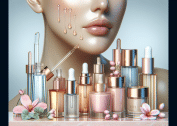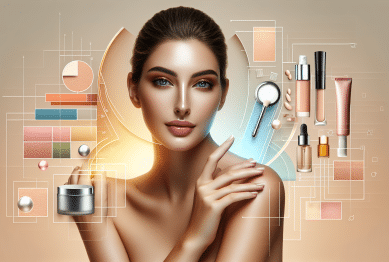Feeling like your complexion looks tired or lifeless? Explore evidence-based strategies for dull skin, radiant glow, and real, visible changes in texture and tone. This guide demystifies how hydration, nutrition, and daily care help transform skin vitality in ways you might not expect.
Understanding Why Skin Looks Dull
Many people notice a lack of vibrance in their skin at different points in their lives. Dullness often shows as uneven tone, rough patches, or a lack of healthy glow, but what actually causes it? Skin texture and appearance are influenced by multiple factors, including the natural aging process, environmental exposure, and changes in cellular renewal rates. Even daily habits such as not removing makeup thoroughly can add to a dull, fatigued complexion. Over time, surface cell buildup slows light reflection, so the skin appears less radiant. Common causes like dry weather, stress, and poor sleep contribute to this problem too (Source: https://www.aad.org/public/everyday-care/skin-care-basics/dry/revitalize-dull-tired-skin).
Skin cell turnover naturally declines as years go by, which is why young skin appears so smooth and luminous. When older surface cells aren’t shed regularly, they form a barrier that can trap oil, dirt, and pollutants, further reducing brightness. Environmental culprits such as ultraviolet (UV) rays, pollution, and smoking can accelerate this dulling effect, damaging collagen production and limiting blood flow to the epidermis. Inadequate hydration is another leading cause, as dehydrated skin struggles to reflect light, losing its natural sheen.
While genetics plays a part, many lifestyle choices impact the skin’s surface and deeper layers. Lack of exercise, inconsistent sleep, and diets low in antioxidants commonly lead to less resilient skin. The result is a complexion that seems almost shadowed or grayish despite regular cleansing. Fortunately, recognizing these influences is the first step toward addressing them. Understanding how each factor plays a role guides you to target changes that foster brighter, healthier-looking skin.
Daily Habits to Restore Natural Glow
Radiance begins with intentional daily routines. Gentle cleansing twice a day removes dirt, excess oil, and makeup without stripping away essential moisture. Incorporating hydrating skincare ingredients, like hyaluronic acid, replenishes water reserves deep within the epidermis. Sunscreen is critical: even low-level UV exposure can amplify dullness and uneven pigmentation. Many people are surprised by the impact of regular SPF use—not just as sun protection, but as an active step toward improving skin clarity and tone.
Exfoliation is another pillar of revitalizing a dull complexion. Whether choosing a chemical exfoliant (such as glycolic acid) or a gentler physical scrub, sloughing away surface debris helps energize cell turnover and reveals newer, softer skin beneath. However, moderation is vital since over-exfoliation can weaken the skin barrier, causing irritation and persistent redness rather than glow. Many dermatologists recommend exfoliating one to two times a week and pairing it with a nourishing moisturizer for barrier protection.
Simple lifestyle shifts—including increasing hydration, improving sleep quality, and supporting healthy movement—directly influence the look and bounce of the skin. Drinking enough water supports elasticity and prevents tightness, while quality sleep is known to boost skin repair overnight. A consistent circadian rhythm and regular, restorative movement (even brisk walking) increase blood flow, nourish cells, and may reduce puffiness. Combined, these routines create an environment for glowing, resilient skin (Source: https://www.ncbi.nlm.nih.gov/pmc/articles/PMC7291977/).
The Nutrition Link: Eating for Bright, Healthy Skin
“You are what you eat”—especially true when it comes to skin vitality. Nutrients rich in antioxidants, including vitamins C, E, and A, defend against oxidative stress, which can make skin appear tired and dull. Berries, leafy greens, sweet potatoes, and citrus fruits are powerful additions to a skin-brightening diet. Additionally, healthy fats such as those found in avocados and nuts boost moisture retention, supporting a more supple surface texture.
Collagen is a building block for skin’s firmness and youthful bounce, yet natural production declines with age. Incorporating foods high in vitamin C and amino acids can support the body’s ability to synthesize collagen, with benefits not just for wrinkle prevention but also for an even and luminous tone. It’s not just about isolated ingredients—the overall pattern of eating matters. Diets high in sugars or processed foods can lead to glycation, a process that may hinder radiance and elasticity (Source: https://www.hsph.harvard.edu/nutritionsource/vitamins/vitamin-c/).
Staying hydrated through a combination of water, herbal teas, and water-rich produce helps maintain cellular plumpness and encourages waste elimination through the skin’s natural processes. Some find that reducing caffeine or alcohol intake provides an added boost in skin clarity. Consulting a registered dietitian for personalized guidance ensures nutritional needs are met for robust overall wellness—not just for fleeting cosmetic improvement, but for supporting the skin as a living, dynamic organ.
Topical Ingredients Proven to Increase Radiance
Several science-backed topical ingredients play starring roles in reviving dull skin. Vitamin C serums are widely recognized for their brightening, antioxidant, and collagen-boosting benefits. When applied in the morning, vitamin C can help neutralize free radicals from pollutants and UV light, supporting a smoother, more uniform tone. Niacinamide, another powerhouse, strengthens the skin barrier and helps reduce blotchy texture, making the complexion appear fresh and clear (Source: https://www.ncbi.nlm.nih.gov/pmc/articles/PMC6533874/).
Retinoids, derivatives of vitamin A, encourage faster skin cell turnover and are often used in targeted regimens for dullness and early signs of aging. Over-the-counter retinol products can provide gradual brightening, while prescription versions yield faster results but may require adjustment to minimize sensitivity. It’s important to use retinoids alongside broad-spectrum SPF, since they can increase sun sensitivity. Those with especially delicate skin may prefer gentler alternatives, like bakuchiol.
Hydrating ingredients, such as ceramides and glycerin, reinforce the skin’s barrier and lock in moisture for a healthy glow. Many people also benefit from antioxidants like green tea extract or resveratrol, which soothe environmental stress. The key is consistency and patience—results often build gradually, so long-term use is essential for sustained improvements. Consulting a board-certified dermatologist helps identify which formulations align with individual skin needs and sensitivities.
Mindfulness, Stress Management, and Their Impact on Skin
The body’s stress response can instantly influence the appearance of skin. Chronic emotional stress triggers the release of cortisol, a hormone that undermines skin healing, weakens its protective barrier, and can stimulate increased oil production. This cycle fosters inflammation, dullness, and in some cases, conditions such as eczema or acne. Many people notice improvements in clarity and evenness once they begin integrating mindfulness or stress-relief practices into their lives (Source: https://www.ncbi.nlm.nih.gov/pmc/articles/PMC4445895/).
Regular activities that calm the nervous system support the skin indirectly. Practices such as meditation, deep breathing, and gentle yoga have been shown to reduce inflammation and promote a restorative environment for cell regeneration. Some researchers believe that certain stress-reduction approaches may even help regulate the skin’s microcirculation, promoting greater radiance over time. A sense of calm appears on the face as a subtle inner glow—one that can’t always be achieved through topical care alone.
Building emotional resilience is as important as daily skincare for revitalizing the complexion. Connecting social support, engaging in hobbies, and taking breaks from digital stress are practical, evidence-based strategies. Working closely with a wellness or mental health professional provides even deeper insight into how emotional well-being plays an essential role in visible, radiant skin. A holistic approach, combining both external and internal practices, fosters a lasting sense of vibrance and glow.
When to Seek Professional Advice for Skin Concerns
Sometimes, dullness is more than just a temporary condition or cosmetic concern. Persistent or rapidly changing skin appearance can signal underlying health issues, including hormonal imbalances, nutritional deficiencies, or chronic dermatological conditions. Consulting a board-certified dermatologist can help identify root causes and develop a tailored treatment plan. Dermatologists may recommend prescription-strength topical or oral therapies, light-based treatments, or detailed diagnostic labs if needed.
For those struggling with conditions like melasma, significant pigmentation, or ongoing sensitivity, professional guidance supports effective and safe improvement. In-office procedures—such as chemical peels, microdermabrasion, or low-level laser therapy—can accelerate results where at-home options fall short. It’s important to take a cautious, individualized approach, considering both the benefits and risks of each intervention (Source: https://www.aad.org/public/diseases/a-z/skin-conditions).
During these visits, discussing nutrition, skincare routines, and concurrent stressors can provide a complete picture, leading to more sustainable outcomes. Skin health is both science and art—a collaborative, ongoing process that moves well beyond surface-level solutions. Seeking professional insights signals an empowering step toward both appearance and holistic wellness.
References
1. American Academy of Dermatology. (n.d.). Revitalize dull, tired skin. Retrieved from https://www.aad.org/public/everyday-care/skin-care-basics/dry/revitalize-dull-tired-skin
2. Nawrot, P., et al. (2020). Influence of Hydration on Skin Physiology. Retrieved from https://www.ncbi.nlm.nih.gov/pmc/articles/PMC7291977/
3. Harvard T.H. Chan School of Public Health. (n.d.). Vitamin C. Retrieved from https://www.hsph.harvard.edu/nutritionsource/vitamins/vitamin-c/
4. Lupo, M.P. (2017). Antioxidants and skin health. Retrieved from https://www.ncbi.nlm.nih.gov/pmc/articles/PMC6533874/
5. Kim, J.E., et al. (2015). Mindfulness and skin health. Retrieved from https://www.ncbi.nlm.nih.gov/pmc/articles/PMC4445895/
6. American Academy of Dermatology. (n.d.). Skin conditions: A-Z. Retrieved from https://www.aad.org/public/diseases/a-z/skin-conditions









